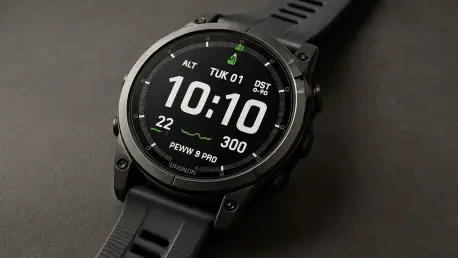Imagine venturing into the wilderness, miles from civilization, with a device on your wrist that not only tracks your every move but also keeps you connected through satellite technology, offering a lifeline in remote areas. This is the promise of Garmin’s latest release, the Fenix 8 Pro series, a high-end smartwatch line that has sparked intense discussion among tech enthusiasts and outdoor adventurers alike. Priced starting at $1,199.99, these wearables aim to redefine premium innovation in a crowded market. This roundup gathers diverse perspectives from industry analysts, user communities, and tech reviewers to explore the standout features, potential drawbacks, and overall value of this ambitious launch. The goal is to provide a balanced view of whether this series truly sets a new standard for rugged, connected wearables.
Diving into Market Reactions and First Impressions
Initial reactions to the Fenix 8 Pro series highlight its bold positioning as a niche product for serious adventurers. Industry observers have noted Garmin’s strategic timing, launching just before a major Apple event, to capture attention in the high-end smartwatch segment. Many agree that with prices soaring up to $1,999.99 for the MicroLED variant, Garmin is targeting an affluent demographic willing to invest in cutting-edge tech for extreme conditions.
Feedback from early adopters in online forums suggests a mix of awe and skepticism. While the rugged design and promise of off-grid connectivity resonate with outdoor enthusiasts, some question if the cost aligns with the practical benefits for the average user. This divide sets the stage for a deeper look into specific features, as opinions vary widely on whether Garmin has hit the mark or overreached with its pricing strategy.
Unpacking Key Features Through Expert Lenses
Satellite Connectivity: A Game-Changer or Gimmick?
The integration of cellular and satellite connectivity via Garmin’s inReach technology has been a focal point of discussion. Tech analysts praise this feature for enabling voice calls, 30-second voice messages, and location tracking in remote areas, positioning the device as a potential lifesaver for off-grid explorers. The ability to stay connected without cellular coverage is seen as a significant step forward in wearable tech.
However, not all feedback is glowing. Some reviewers point out that the implementation feels less seamless compared to connectivity options on rival devices from Apple or Samsung. The added $9.99 monthly subscription for inReach services has also drawn criticism, with user communities debating whether this recurring cost undermines the value proposition for budget-conscious buyers.
A contrasting view from outdoor gear blogs emphasizes the practical utility for niche users like mountaineers or long-distance hikers. These sources argue that despite the subscription fee, the peace of mind offered by reliable communication in emergencies could outweigh the expense for those who truly need it. This split in opinion underscores the feature’s targeted appeal.
MicroLED Display: Visual Brilliance at a Cost
The Fenix 8 Pro – MicroLED model, touted for its 4,500-nit brightness, has been hailed as a breakthrough in display technology by several tech reviewers. This level of visibility, ideal for harsh sunlight conditions, is frequently cited as a standout for outdoor activities like climbing or desert trekking. Many see it as a clear differentiator from the standard AMOLED model and competitors’ offerings.
Yet, the trade-off of reduced battery life—down to 10 days compared to 27 days for the base model—has sparked concern. Industry commentators highlight that at $1,999.99, the price jump for this visual upgrade feels steep, especially when battery endurance is a priority for remote adventures. Some question if the brightness justifies such a premium for most users.
User feedback from early testing phases, as shared in tech discussion boards, reveals a practical divide. While professional athletes and outdoor guides appreciate the readability in extreme environments, casual users find the cost prohibitive for marginal day-to-day benefits. This feature, while innovative, appears to cater to a very specific audience.
Battery Life: A Defining Strength Under Scrutiny
Garmin’s reputation for long-lasting wearables shines through with the Fenix 8 Pro series, as the standard model boasts up to 27 days of battery life. Tech blogs consistently rank this as a top feature, especially for users who prioritize reliability during extended trips without access to charging. Analysts note that this endurance outpaces anticipated specs of devices like the Apple Watch Ultra 3.
Despite this strength, some industry voices argue that battery life alone may not expand Garmin’s market reach. With pricing that excludes mainstream consumers, the appeal remains limited to a niche group. Reviewers suggest that while the numbers are impressive, the real-world impact depends on how users balance power-intensive features like satellite tracking or display brightness.
A different angle comes from fitness-focused communities, where members emphasize the value of not needing frequent charges during multi-day events or training camps. This perspective reinforces Garmin’s edge among dedicated outdoor enthusiasts, though it also highlights the challenge of justifying the cost to a broader audience less focused on endurance.
Health and Fitness Tools: Comprehensive but Overshadowed
Both models of the Fenix 8 Pro series come equipped with an extensive suite of health and fitness features, including ECG monitoring, sleep coaching, and topographic maps. Wellness tech reviewers commend Garmin for maintaining a robust all-in-one package that supports active lifestyles, aligning with industry standards set by competitors.
However, several analyses point out that these tools are often overshadowed by the marketing focus on connectivity and display innovations. Some critics in the wearable tech space argue that Garmin could have pushed further in differentiating its health offerings, especially at this price point, to attract a wider demographic beyond adventure seekers.
Feedback from user groups reveals a practical appreciation for features like daily workout suggestions and safety tracking, particularly for solo adventurers. Yet, there’s a recurring sentiment that these capabilities, while solid, don’t feel like the primary draw of the device, leaving room for future iterations to emphasize wellness tech more prominently.
Weighing the Value for Potential Buyers
Synthesizing opinions across sources, the Fenix 8 Pro series emerges as a polarizing product with exceptional strengths tailored to a select few. Tech industry insights lean toward recommending the standard model at $1,199.99 as the better value, offering a balance of battery life, features, and (relative) affordability. The MicroLED variant, while technologically impressive, is often seen as a luxury reserved for those prioritizing display quality over practicality.
User communities and reviewers alike stress the importance of aligning purchase decisions with specific needs. For those venturing into remote areas, the satellite connectivity might be worth the investment, despite additional costs. Conversely, for urban users or casual fitness enthusiasts, more accessible alternatives from Apple or Samsung frequently come up as preferable options in discussions.
A recurring tip from multiple analyses is to evaluate the total cost of ownership, including subscription fees for inReach services. Many sources advise potential buyers to test the device’s core features against personal use cases—be it durability for rugged terrains or off-grid communication—before committing to such a premium price tag.
Reflecting on the Broader Impact and Next Steps
Looking back, the discourse surrounding Garmin’s Fenix 8 Pro series paints a picture of innovation aimed at a niche yet passionate audience. The diverse opinions gathered from tech reviewers, industry analysts, and user communities highlight both the groundbreaking potential of features like satellite connectivity and the barriers posed by steep pricing.
For those intrigued by this release, a practical next step would be to explore hands-on reviews or trial periods offered by retailers to experience the device’s capabilities firsthand. Comparing its rugged features against upcoming models from competitors could also provide clarity on long-term value. Additionally, keeping an eye on how Garmin addresses feedback about subscription costs or connectivity integration in future updates might offer insight into the brand’s evolving strategy for balancing premium innovation with accessibility.









